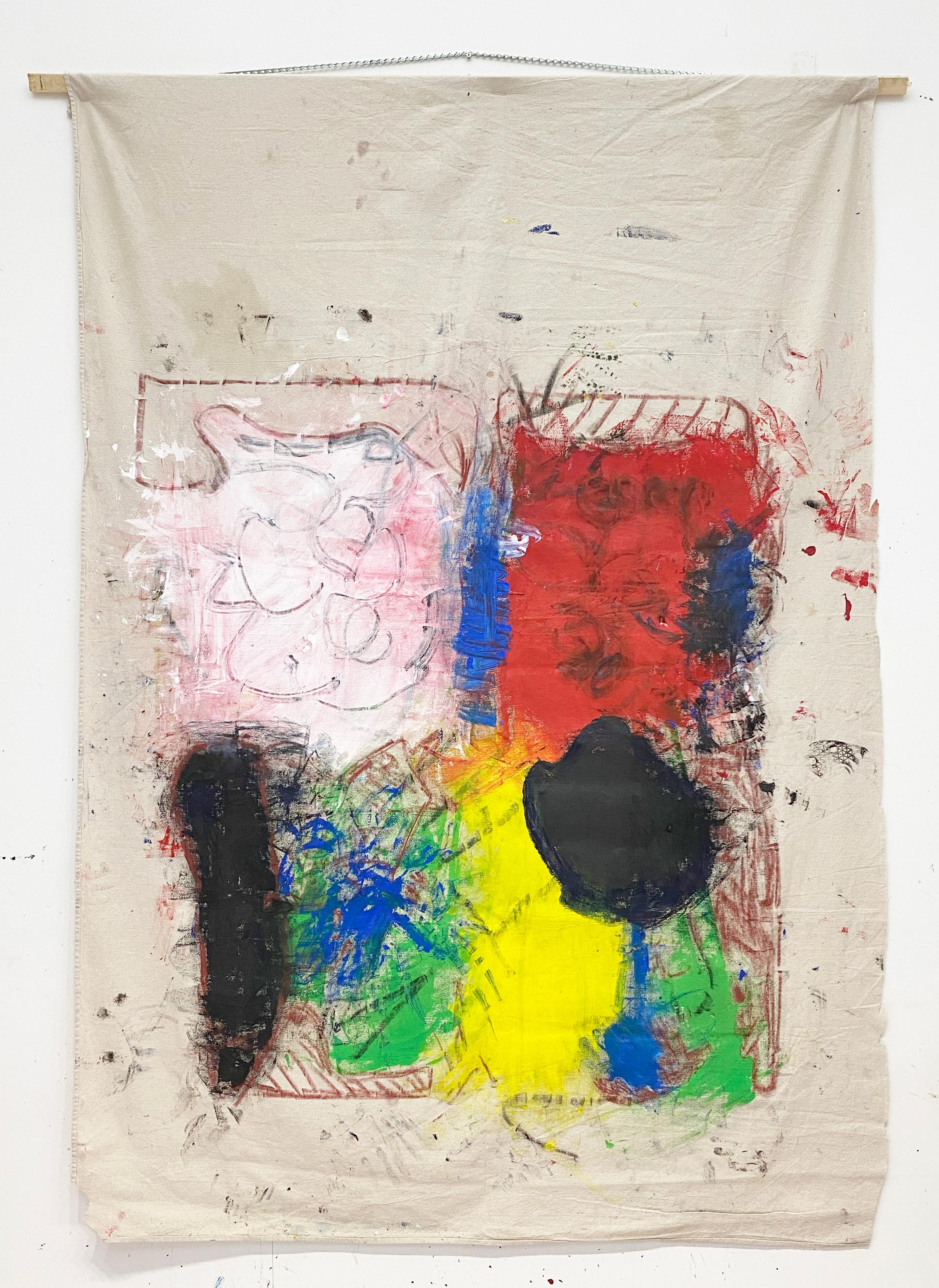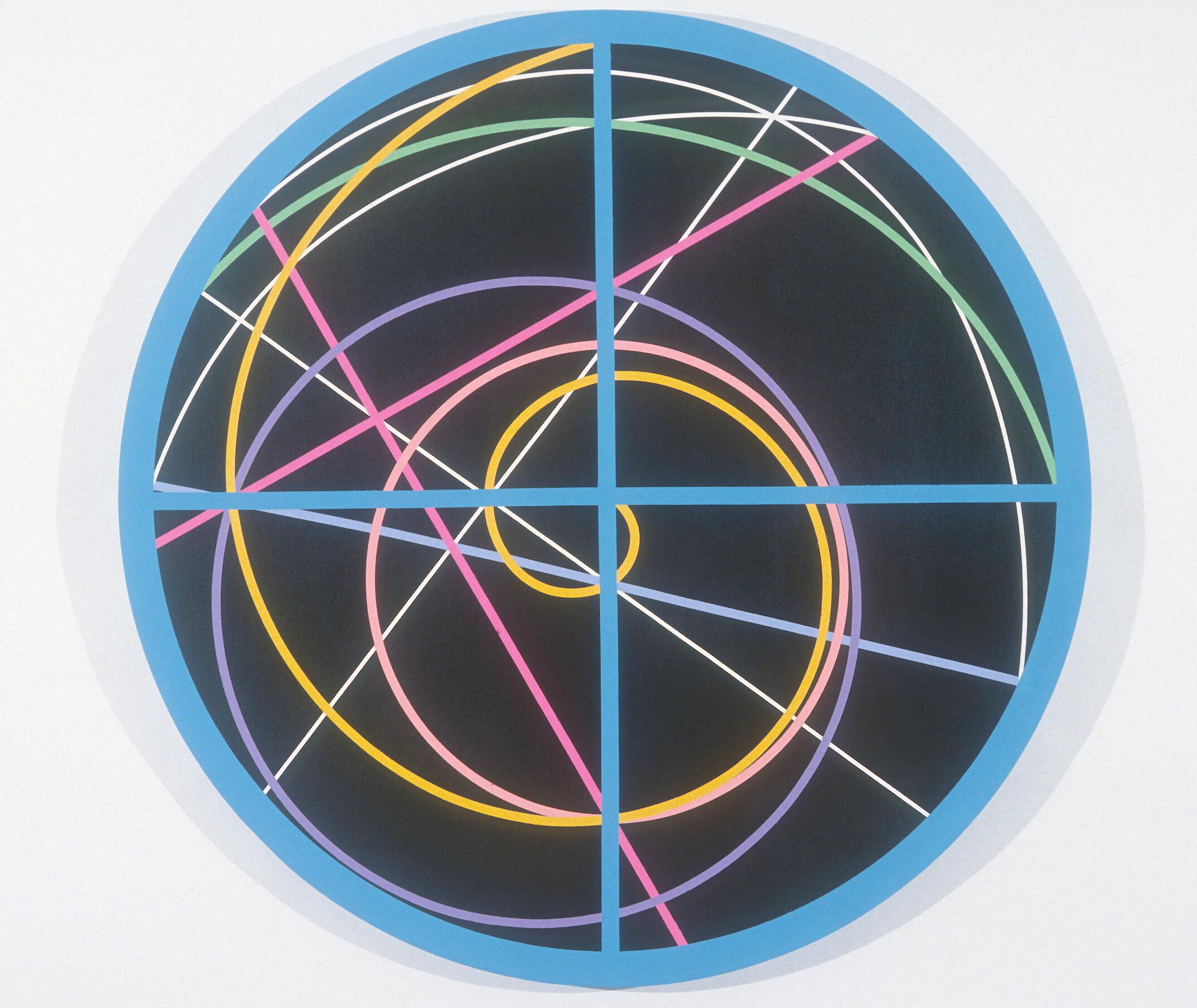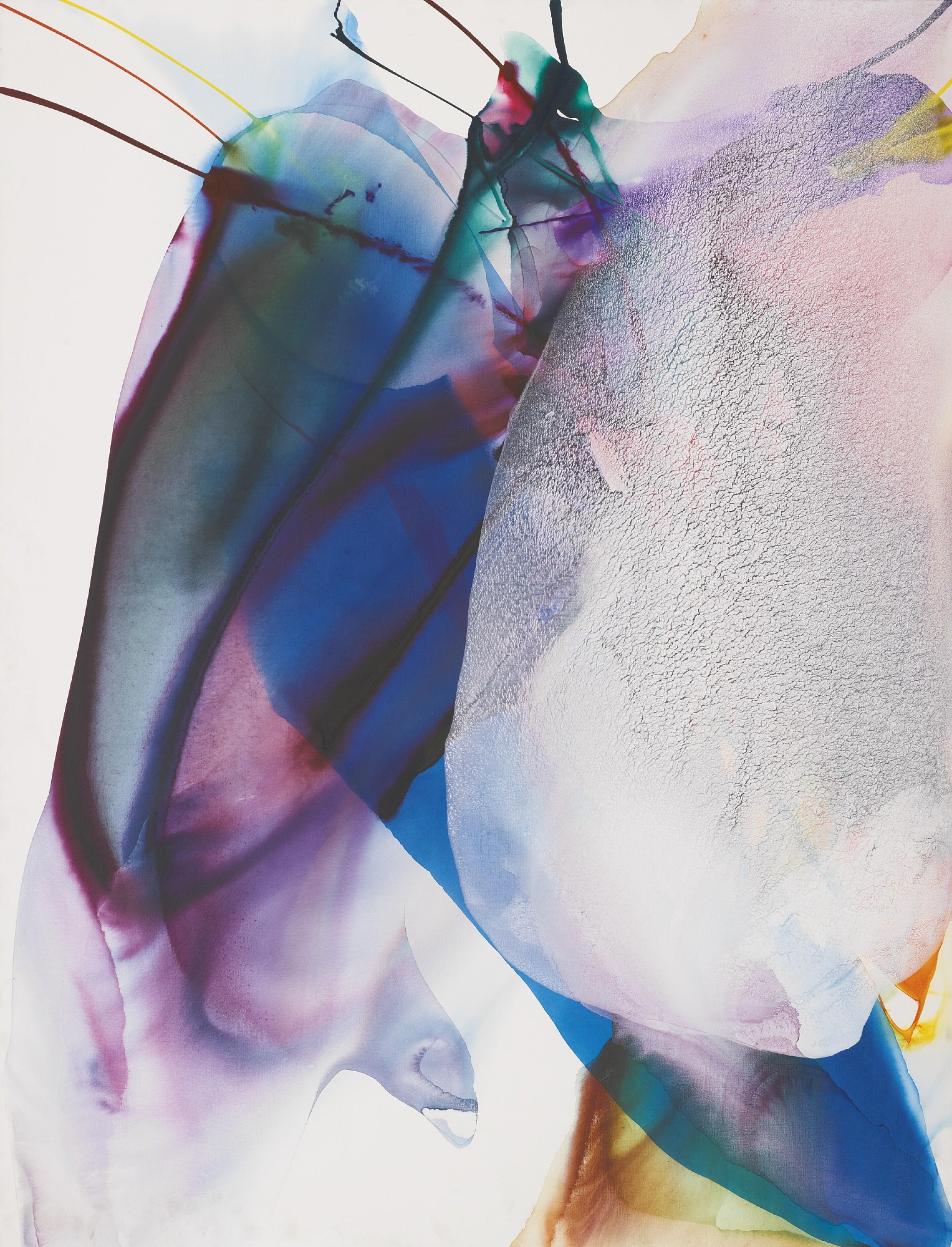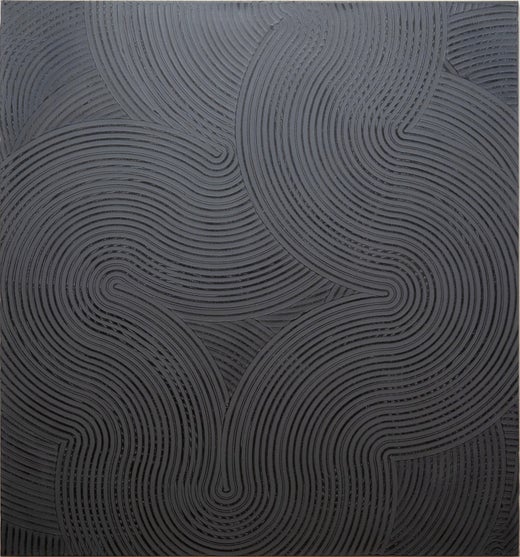Articles similaires à Peinture à l'huile géométrique abstraite originale Duanye Hatchett - Œuvre d'origine moderniste
Vous voulez plus d'images ou de vidéos ?
Demander au vendeur plus d'images ou de vidéos
Duanye HatchettPeinture à l'huile géométrique abstraite originale Duanye Hatchett - Œuvre d'origine moderniste1994
1994
À propos de cet article
An abstract painting by Duayne Hatchett from his Trowel Painting Series. Oil on canvas, circa 1990. Signé. Encadré.
Duayne Hatchett was a visual artist whose work included prints, paintings, sculpture, and found objects. He was born on May 12, 1925 in Shawnee, Oklahoma. He enlisted in the Air Force where he trained to become a fighter pilot. After leaving the militrary he studied design at the University of Oklahoma. His highly technical military training combined a mathematical intelligence with a love for physics and a daring embrace of new experience, all of which would soon be the tools for his evolution through art.
Two major influences interacted on his early development at OU. Emelio Omero, a colleague and close friend of Diego Rivera, introduced him to the revolutionary art ideas of Mexico City, while teaching him a wide range of printing techniques that would culminate in a Masters Degree in Painting in 1952. During this time he met Bruce Goff, a renowned Wright disciple, who was teaching architecture at OU and befriended Hatchett, introducing him to the most avant-garde architecture of that time.
He spent his summers while at OU designing for a small sign shop, which introduced him to new materials used for building neon, plastic, and metal signs. The use of new materials and a keen sense for design would soon become invaluable building blocks for future sculpture. During this time he met and married Mary Ellen Jeffries. They would spend their lives together and raise three children, David (me), my brother Dana, and my sister Jeffri. As children, they were immersed in art from childhood and benefited greatly from this loving art and domestic environment.
Hatchett was always interested in the techniques of construction, often watching different tradesmen working, understanding how materials are put together to create the manmade environment that surrounded him. While teaching printmaking at Oklahoma City University from 1951 through ‘54, he began to build sculpture employing some of the materials and techniques that he saw workers using. He was beginning to draw the attention of architects and he became interested in their work-trade processes, moving from blue prints to construction. He accepted an invitation from Alexander Hogue to teach sculpture at Tulsa University in 1954. He moved his family to Tulsa where he would teach for the next ten years.
While in Tulsa, he became well known as a teacher and a sculptor, often lecturing at various sculpture conferences around the country. He also began to obtain commissions for sculpture as his interaction with architecture continued to evolve. He began to meet and interact with some of the most influential New York artists, including David Smith, Louise Nevelson, Noguchi, and Chicago artist, Richard Hunt.
The 'found object' became important subject matter for many artists including Hatchett and his frequent trips to junkyards yielded the materials for welded sculptures that explored abstract forms suggestive of the world around him. Sources of inspiration ranged from a dead cat smashed on the road to Sputnik orbiting the earth. Alan Stone Gallery in New York City, arranged to show two of these pieces at the Museum of Modern Art in 1963.
He was offered a teaching job at Ohio State University in 1964, where he would teach sculpture for the next three years, and make a leap of imagination that would propel his art into the museums and galleries in New York City and beyond. He began by moving away from combining found objects to using found materials to fabricate objects that he called "Totems." Royal Marks Gallery in New York City began to represent Hatchett in 1964 and arranged for him to be included in the ‘Young American Sculpture East to West’ show representing the United States in the 1964 New York World’s Fair. He would then leave any hint of the found object or junk material behind (until the 90’s) and move into pure abstraction, what can only be described as 'Modern' Art.
Taking his cue from modern architecture, he began to draw simplified volumes and planes, minimally rendered, so as to be easily grasped as a whole. Built with industrial materials, sheet metals and plastics, the images suggested the look of modern technology and architectural accuracy in the environment. These new works resulted in multiple one-person shows, including shows at Royal Marks Gallery in 1965, ’68, ’69, and ’70, and defined a major shift in his work that would be played out for the next two decades. He was featured on the cover of the Whitney Annual and the Whitney Museum acquired a large sculpture in 1967. He was included in the American Sculpture of the Sixties show at the Los Angeles County Museum and the Pittsburgh International, at the Carnegie Institute Museum of Art that same year.
In 1968 he took a teaching position at the University of Buffalo where he would head the sculpture department for the next 24 years and he would move his art in multiple directions. He began a series of paintings to exploit the simple line drawings previously used to define the plate metal sculpture. These paintings explored the optical relativity of two and three-dimensional space depicted on a flat plane. He was also continuing to develop his geometric minimalist sculptures, landing several sculpture commissions around the country. In 1974, the Albright-Knox Art Gallery in Buffalo, NY presented, Duayne Hatchett: Recent Paintings and Sculpture. In the ensuing years his work would be shown in one person and group shows around the country. In the studio, the confluence of construction and the 'Found Object' re-entered his work in a completely unexpected way. Construction itself became the creative engine transforming his new art.
New tools and working processes were adopted or invented to create new art. The trowel would replace the brush for building new paintings. Tools for rolling and burnishing metal would be invented and riveting would be adopted to build new sculptures. He was influenced by the characteristics of materials and objects such as corrugated sheet metals, the optical effects of plastics, metal grates, tin cans, seen in his man made environment, as well as crosscut tree logs and drift wood from his natural environment. He began to build sculptures, in the privacy of his studio, largely unseen by the public.
In the late 90’s, the found object re-emerged in the form of new sculpture created from railroad spikes welded together to form organic conglomerations reminiscent of nature. He also began to build assemblages of found objects and materials that maintained a continuous flat surface, which were simultaneously sculptures as well as being blocks for prints. By utilizing a wide range of printing techniques that he invented, he made mono-prints that record the image of the assembled material constructions, greatly extending his previous uses of the found object, and greatly expanding the imagery in his printmaking.
From printmaking and painting of the late 40’s, influenced by Mexican Art, through the junk metal used from found objects in the 50’s and early 60’s, through the minimalist sculpture and paintings influenced by modern architecture from the 60’s and 70’s, to the paintings, sculpture and printmaking of the last forty years, Duayne Hatchett has developed a personal expression that solicits a universal response. His unique visual language has been created through the invention of tools, the manipulation of various materials and objects, which he presents in a unified form. These expressions reflect our environment, specifically and generally, as objects once in use or patterns at play. Hatchett’s art works are interactive vessels that hold their content as potential energy, waiting to unlock our memories and our senses through the act of observation.
–David Hatchett, March 2009
Duayne passed away on September 7, 2015.
- Créateur:Duanye Hatchett (1925 - 2015, Américain)
- Année de création:1994
- Dimensions:Hauteur : 45,72 cm (18 po)Largeur : 58,42 cm (23 po)Profondeur : 2,54 cm (1 po)
- Support:
- Mouvement et style:
- Période:
- État:
- Adresse de la galerie:Buffalo, NY
- Numéro de référence:1stDibs : LU13929506492
Duanye Hatchett
Duayne Hatchett était un artiste visuel dont l'œuvre comprend des gravures, des peintures, des sculptures et des objets trouvés. Il est né le 12 mai 1925 à Shawnee, Oklahoma. Il s'est engagé dans l'armée de l'air où il s'est entraîné pour devenir pilote de chasse. Après avoir quitté l'armée, il a étudié le design à l'université d'Oklahoma. Sa formation militaire hautement technique associait une intelligence mathématique à un amour de la physique et à une audace dans l'exploration de nouvelles expériences, autant d'éléments qui allaient bientôt constituer les outils de son évolution artistique. Il accepte une invitation d'Alexander Hogue à enseigner la sculpture à l'université de Tulsa en 1954. Il a déménagé sa famille à Tulsa où il a enseigné pendant les dix années suivantes. Pendant son séjour à Tulsa, il s'est fait connaître en tant que professeur et sculpteur, donnant souvent des conférences sur la sculpture dans tout le pays. Il commence également à obtenir des commandes de sculptures, son interaction avec l'architecture continuant à évoluer. Il commence à rencontrer et à échanger avec certains des artistes les plus influents de New York, notamment David Smith, Louise Nevelson, Noguchi et l'artiste de Chicago, Richard Hunt. En 1968, il a accepté un poste d'enseignant à l'université de Buffalo, où il a dirigé le département de sculpture pendant les 24 années suivantes et a orienté son art dans de multiples directions. Il a commencé une série de peintures pour exploiter les simples dessins au trait utilisés auparavant pour définir la sculpture en métal plat. Ces peintures explorent la relativité optique de l'espace bidimensionnel et tridimensionnel représenté sur un plan plat. Il continue également à développer ses sculptures géométriques minimalistes, décrochant plusieurs commandes de sculptures dans le pays. En 1974, la Albright-Knox Art Gallery de Buffalo, NY, a présenté Duayne Hatchett : Recent Paintings and Sculpture. Dans les années qui ont suivi, ses œuvres ont été présentées dans des expositions individuelles et collectives dans tout le pays. Dans le Studio, la confluence de la construction et de l'objet trouvé a fait son retour dans son travail d'une manière totalement inattendue. La construction elle-même est devenue le moteur créatif qui transforme son nouvel art. De nouveaux outils et procédés de travail ont été adoptés ou inventés pour créer un nouvel art. La truelle remplaçait le pinceau pour construire de nouvelles peintures. Des outils pour laminer et brunir le métal seront inventés et le rivetage sera adopté pour construire de nouvelles sculptures. Il a été influencé par les caractéristiques des matériaux et des objets tels que les tôles ondulées, les effets optiques des plastiques, les grilles métalliques, les boîtes de conserve, observés dans son environnement artificiel, ainsi que les troncs d'arbres coupés et le bois de grève de son environnement naturel. Il a commencé à construire des sculptures, dans l'intimité de son Studio, à l'abri du regard du public. À la fin des années 90, l'objet trouvé réapparaît sous la forme d'une nouvelle sculpture créée à partir de pointes de chemin de fer soudées ensemble pour former des conglomérats organiques rappelant la nature. Il a également commencé à construire des assemblages d'objets et de matériaux trouvés qui maintenaient une surface plane continue, qui étaient à la fois des sculptures et des blocs pour des impressions.
À propos du vendeur
4,9
Vendeur Platine
agréés par des experts, ces vendeurs sont les plus expérimentés sur 1stDibs et les mieux notés par nos clients.
Établi en 1970
Vendeur 1stDibs depuis 2015
2 396 ventes sur 1stDibs
Temps de réponse habituel : 1 heure
- ExpéditionRecherche du devis...Expédition à partir de : Brooklyn, NY
- Politique des retoursCet article peut être retourné sous 2 jours à compter de la date de livraison.
Certaines parties de cette page ont été traduites automatiquement. 1stDibs ne garantit pas l'exactitude des traductions. L'anglais est la langue par défaut de ce site web.
Plus d'articles de ce vendeurTout afficher
- Ensemble de 12 peintures abstraites contemporaines encadrées en bleu et blanc de la collection du muséePar Monica AngleUn ensemble de 12 œuvres originales en techniques mixtes monotype et peinture de l'artiste contemporaine américaine Monica Angle. Ces pièces ont été inspirées par la lumière changea...Catégorie
années 2010, Expressionnisme abstrait, Peintures - Abstrait
MatériauxToile, Papier, Acrylique, Aquarelle
- Paysage volcanique MauiPar Rebecca AllanCe tableau dynamique de l'artiste contemporaine Rebecca Allan peut être accroché dans différentes orientations. Rebecca Allan est une artiste visuelle basée à New York, connue pour ...Catégorie
Début des années 2000, Abstrait, Peintures - Abstrait
MatériauxToile, Acrylique
- Garden GivernyPar Rebecca AllanCe tableau dynamique de l'artiste contemporaine Rebecca Allan peut être accroché dans différentes orientations. Rebecca Allan est une artiste visuelle basée à New York, connue pour ...Catégorie
Début des années 2000, Abstrait, Peintures - Abstrait
MatériauxToile, Acrylique
- Travel as Equals (voyageur en équivalents), (par Joseph Arthur)Par Felice KoenigUne peinture acrylique originale sur toile de l'artiste féminine contemporaine américaine Felice Koenig. Cette pièce fait partie de la série d'œuvres de l'artiste associées à des mo...Catégorie
années 2010, Abstrait, Peintures - Abstrait
MatériauxToile, Acrylique
- La fièvre du printempsPar Toma YovanovichUne peinture expressionniste abstraite moderne du milieu du siècle dernier de l'artiste américain Toma Yovanovich. Toma Yovanovich (1931-2016) était un peintre/imprimeur dont l...Catégorie
années 1960, Abstrait, Peintures - Abstrait
MatériauxAcrylique, Toile
- L'âge d'orPar Winslow TeeUne œuvre originale réalisée à l'acrylique, à l'encre et au spray sur une toile sculpturale par l'artiste conceptuel Winslow Tee, basé à Brooklyn, NY. La toile a été découpée et scu...Catégorie
années 2010, Abstrait, Peintures - Abstrait
MatériauxToile, Acrylique
Suggestions
- Ruz Vertical Lignes horizontales. Paysages d'intérieur - AbstraitPar Rafael RuzRuz. lignes horizontales. Paysages d'intérieur - Abstrait Acrylique sur toile . Parfait état. RUZ, Rafael (Barcelone 1956) En contemplant le tableau de Ruz, nous sommes enclins à pa...Catégorie
XXIe siècle et contemporain, Abstrait, Peintures - Abstrait
MatériauxToile, Acrylique
- Œuvre d'art expressionniste abstraite JP TPŒuvre d'art expressionniste abstraite de Joseph Hicks. Les œuvres de Joseph Hicks sont lumineuses et colorées, pleines de vie et de créativité. Ses toiles sont pleines d'énergie et...Catégorie
années 2010, Expressionnisme abstrait, Peintures - Abstrait
MatériauxToile, Crayon gras, Technique mixte, Acrylique
- Série SpiralPar Clifford SingerTondo. Clifford Singer avait réalisé plusieurs peintures tondo à la fin des années 1980, qui travaillaient avec des spirales.Catégorie
années 1980, Géométrique abstrait, Peintures - Abstrait
MatériauxAcrylique, Toile
- Resurrection printanièrePar Ronnie LandfieldAcrylique sur toile. Signé, titré et daté au verso. 86 x 74 in. 87.25 x 75.25 in. (encadré) Veuillez noter : Notre Studio d'encadrement n'a pas pu prendre en charge l'échelle de ce...Catégorie
années 1980, Géométrique abstrait, Peintures - Abstrait
MatériauxToile, Acrylique
- Cheminée Phenomena West Mantle (1968). Peinture à l'acrylique sur toile de Paul JenkinsPar Paul JenkinsUn exemple emblématique de la maîtrise de Paul Jenkins. Ce n'est pas par hasard que Phenomena West Mantle a été choisi comme couverture du catalogue de l'exposition révolutionnaire "...Catégorie
années 1960, Expressionnisme abstrait, Peintures - Abstrait
MatériauxAcrylique, Toile
- TumblePar Charles ArnoldiCharles Arnoldi est un peintre, sculpteur et graveur américain. Il est né le 10 avril 1946 à Dayton, dans l'Ohio. Charles Artistics a été décrit comme un artiste qui "dessine dans l...Catégorie
Début des années 2000, Géométrique abstrait, Peintures - Abstrait
MatériauxToile, Acrylique





